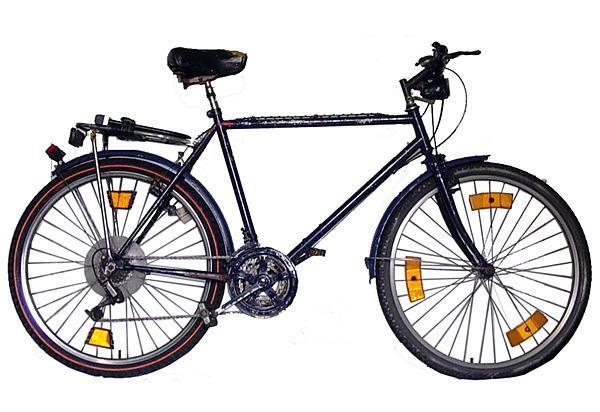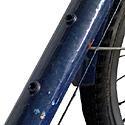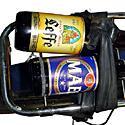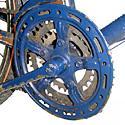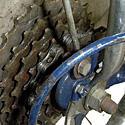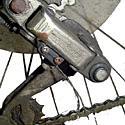
Recently on Cyclingnews.com |
Reviewed April 1, 2005
Jeff Jones's Belgian MTB commuter special
Belgian Grand CruBy Jeff Jones What do you get when you combine the finest in Japanese technology and Belgian bike craftsmanship? The answer is a delightful synergy of blue steel, aluminium, foam, rubber and plastic that serves tens of thousands of Belgian commuters: The MTB commuter special. Built for Flandrian conditions, this sexy looking beast is the epitome of all the good things about Belgian commuting machines, and has a unique heritage that is often copied but seldom replicated in other European countries. I had the good fortune to come across one of these machines a couple of years ago, when it was donated by two friends. I must stress that, unlike many town bikes, this one was not stolen, and has been kept under secure lock and key on the bike rack down below since its acquisition. The attention to detail in the construction of this fine machine is very impressive indeed. Obviously engineered for reliability, the bike is surprisingly agile, and one can reach 0-15 km/h in a matter of minutes in favourable conditions. It tips the scales at a featherweight 17.5 kg, making it suitable for descending as well as going downhill fast. To achieve this remarkable weight, measures such as removing both the bidon cages, selected rear spokes, and having just six speeds on the rear cluster instead of 10, all combine to make this commuter one of the finest in its class. Of course, hydration is critical while riding, so I found it necessary to rig up a special rubber bidon cage on the back of this machine. This enabled me to carry two bottles of the best quality Belgian beer for those extra long commutes. Remember, always try to drink a litre per hour. If Westmalle Tripel (9%) is too strong, then you may have to scale back to Leffe Blond (6.6%). Despite the attention to detail on the weight front, it's also evident that the designers have expended considerable mental energy on the paint job. The basic matt blue colour is overlaid on a ferrous oxide base, and in certain areas of the frame there is some beautiful filigree paint work. It's truly eye-catching and several passers-by have remarked on how striking the artwork is. Further adding to the aesthetic appeal of the bike, possibly at the expense of a few grams, is a pair of dynamo lights, which appear to be based on a rare 19th century design of Moses Farmer and Thomas Edison. The lights, alas, are no longer functional, and are purely for ornamental purposes. One of the most important areas of the MTB commuter special is the saddle and seatpost. The latter has apparently been welded into the frame, making adjustment quite difficult. I feel this is one of the negative points of the bike, which otherwise is perfect in all aspects. But the saddle, which is made from a large amount of foam and a small amount of vinyl, partially makes up for it. Forget a superlight carbon fibre job - this is what you need to plant your butt on. It's water and snow absorbent too, but only while not being sat on. The wheels are, for the most part, round and contain between 36 and 44 spokes. A Maxxis rear tyre and a somewhat indeterminate Korean model on the front combine to give a set of sub-6 kg wheels, which many pro's would eye with envy when lining up for a mountain time trial. But again, the performance has not been compromised and these beauties make riding over cobbles an almost pleasurable experience. Stopping power is via a special set of cantilevered brakes, which are more powerful than any dual pivot system known to man. I did find that some caution was necessary when applying the brakes, otherwise the bike was likely to skid to a halt from cruising speed in less than 400 metres, causing stress. The heart of the MTB commuter special is in the drive train, and again some weight has been saved here with the choice of a six speed rear cluster (28-14), rather than the usual 10. On the other hand, the triple chainring (48/40/32) on the front almost makes up for this, so gear selection is in no way compromised. This was particularly important when climbing the ramp over the railway or sprinting against other commuters in peak hour, where one bad gear change could cost valuable minutes. To make it all work, the rear derailleur has to be rock solid, and I found the Shimano Tourney gave crisp, clean shifting every time, without ever dropping the chain. On one occasion, the chain actually snapped, but I hold that this had nothing to do with the fact that I hadn't oiled it for four months over the Belgian winter. Overall, the Belgian MTB commuter special captures the essence of Flanders to a T, and is undoubtedly part of the armoury of any true Flandrian pro. Top marks! Photos
Images by Jeff Jones/Cyclingnews.com
| |||||
Full specificationFrame: Reinforced steel Measurements Cranks: Dark blue, tripel |
Rims: Wide, silver Bar/Stem: Possibly an offcut of the frame | ||||

